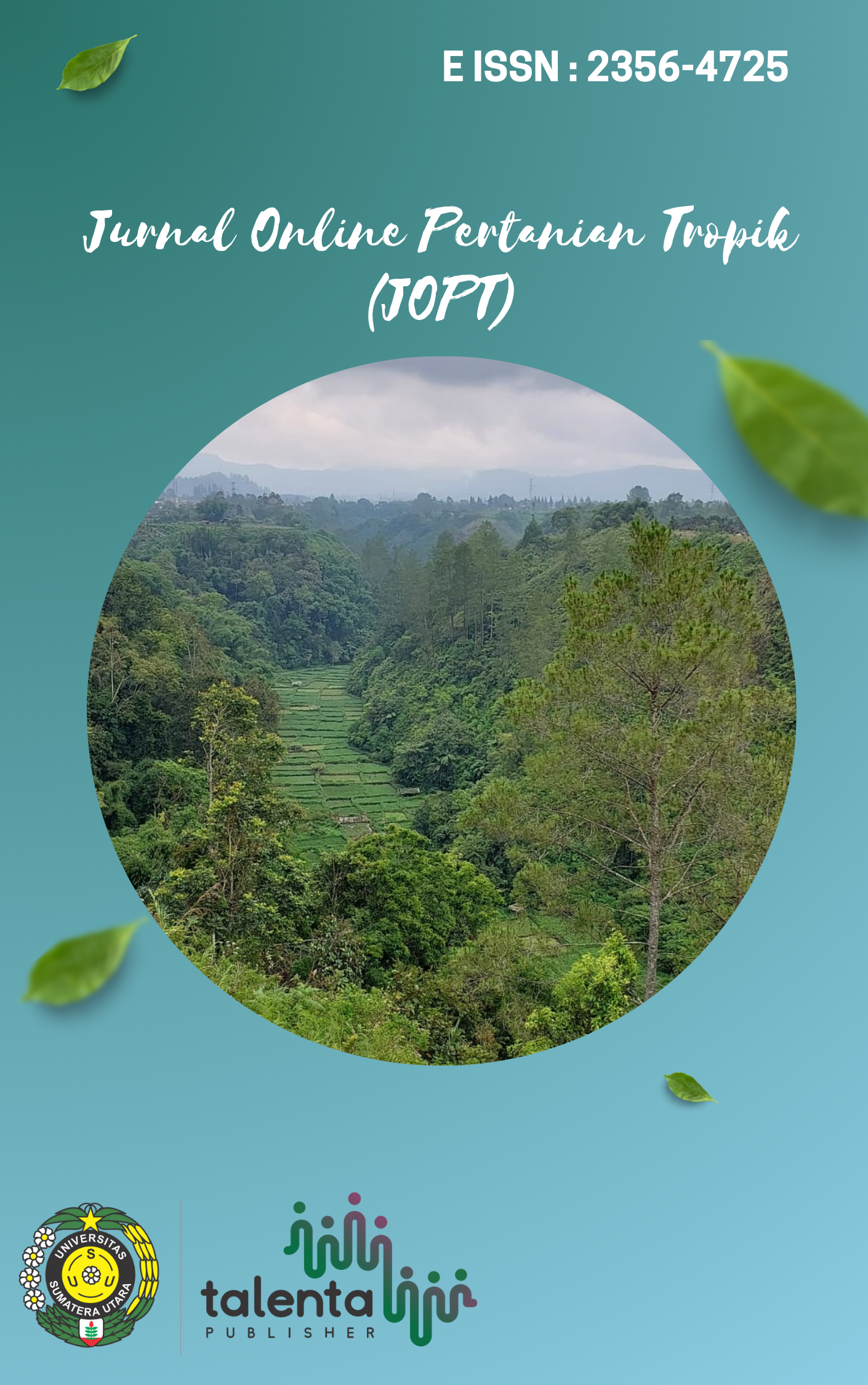Application of Turmeric Extract Botanical Insecticide On Feeding Activity And Mortality Of Spodoptera Litura Larvae
DOI:
https://doi.org/10.32734/jopt.v10i1.13564Keywords:
Curcuma, efficacy, ethanol,SpodopteraAbstract
This research aimed to evaluate the effectiveness of turmeric extract as a botanical insecticide on the feeding activity and mortality of Spodoptera litura larvae. The method used in this study was a toxicity test using the leaf dip method. The experiment employed a completely randomized design with combinations of turmeric extract concentrations (0, 4, 8, 12, and 16 grams per liter of water) and instar types (1 and 2). The results showed that the application of turmeric extract on cabbage leaves reduced the feeding activity of instar 2 and 3 larvae. Meanwhile, the turmeric extract had an effect on the mortality of instar 2 and 3 larvae only at a concentration of 16%. The symptoms observed in the dead larvae were changes in color and body texture. The conclusion of this research is that 16% is the minimum effective concentration of turmeric extract on instar 2 and 3 S. litura larvae. This study should be continued on other instar types at the field scale.
Downloads
References
Amalraj, A., Pius, A., Gopi, S., & Gopi, S. (2017). Biological activities of curcuminoids, other biomolecules from turmeric and their derivatives–A review. Journal of Traditional and Complementary Medicine, 7(2), 205–233.
Bajwa, U., & Sandhu, K. S. (2014). Effect of handling and processing on pesticide residues in food-a review. Journal of Food Science and Technology, 51, 201–220.
Gaur, N., & Mogalapu, S. (2018). Pests of soybean. Pests and Their Management, 137–162.
Ghosh, E., Varshney, R., & Venkatesan, R. (2022). Performance of larval parasitoid, Bracon brevicornis on two Spodoptera hosts: Implication in bio-control of Spodoptera frugiperda. Journal of Pest Science, 1–12.
Gopika, R., Sonkamble, M. M., & Lad, A. G. (2022). Seasonal incidence of major insect pests of cabbage and their correlation with weather parameters. Journal of Entomological Research, 46(1), 154–157.
Hanlon, S. M., & Parris, M. J. (2014). The interactive effects of chytrid fungus, pesticides, and exposure timing on gray treefrog (Hyla versicolor) larvae. Environmental Toxicology and Chemistry, 33(1), 216–222.
Harahap, S., Siregar, E. S., & Mahmud, A. (2022). Effectiveness of pest control of cocoa fruit (Conopomorpha cramerella) using pruning and vegetable insecticide treatment on cocoa (Theobroma cacao L). Jurnal Pertanian Tropik, 9(2), 138–143.
Hutagalung, R. P. S. ., Sitepu, S. F. ., & Marheni. (2021). Biologi Fall Armyworm (Spodoptera frugiperda J. E. Smith) (Lepidoptera: Noctuidae) di laboratorium. Jurnal Pertanian Tropik , 8(1), 1-10. https://doi.org/10.32734/jpt.v8i1.5584
Kanyile, S. N., Engl, T., & Kaltenpoth, M. (2022). Nutritional symbionts enhance structural defence against predation and fungal infection in a grain pest beetle. Journal of Experimental Biology, 225(1), jeb243593.
Krams, I., Kecko, S., Kangassalo, K., Moore, F. R., Jankevics, E., Inashkina, I., Krama, T., Lietuvietis, V., Meija, L., & Rantala, M. J. (2015). Effects of food quality on tradeâ€offs among growth, immunity and survival in the greater wax moth Galleria mellonella. Insect Science, 22(3), 431–439.
Kumar, R., Khan, F., & Acharya, A. (2022). Bio-pesticidal efficacy of neem and turmeric extract. Int. J. Social Sci. & Ecol, 7, 948–955.
Ment, D., Shikano, I., & Glazer, I. (2017). Abiotic factors. Ecology of Invertebrate Diseases, 143–186.
Nagata, S., & Zhou, Y. J. (2019). Feeding-modulating neuropeptides and peptide hormones in insects. Advances in Insect Physiology, 57, 137–172.
Rezende-Teixeira, P., Dusi, R. G., Jimenez, P. C., Espindola, L. S., & Costa-Lotufo, L. V. (2022). What can we learn from commercial insecticides? Efficacy, toxicity, environmental impacts, and future developments. Environmental Pollution, 118983.
Roy, G. C., Chakraborty, K., & Parthasarathi Nandy, M. N. (2014a). Pros and cons of curcumin as bioactive phytocompound for effective management of insect pest. American Scientific Research Journal for Engineering, Technology, and Sciences, 7(1), 31–43.
Roy, G. C., Chakraborty, K., & Parthasarathi Nandy, M. N. (2014b). Pros and cons of curcumin as bioactive phytocompound for effective management of insect pest. American Scientific Research Journal for Engineering, Technology, and Sciences, 7(1), 31–43.
Sari, P. M., Wahyunita, H., Yoesoep, A., & Harahap, F. S. (2019). Insecticide activity extract of Tinospra crispa mixed with cow urine on Spodoptera litura in the laboratory. Jurnal Pertanian Tropik, 6(2), 211–215.
Sánchez-Bayo, F. (2021). Indirect effect of pesticides on insects and other arthropods. Toxics, 9(8), 177.
Shen, N., Liu, H.-Y., Mou, T.-Y., Ma, Y.-B., Li, Y., Song, Z.-J., Tang, T., Han, Z.-J., & Zhao, C.-Q. (2022). Novel metaâ€diamide insecticide, broflanilide, suppresses the population of common cutworm Spodoptera litura through its lethal and sublethal effects. Pest Management Science, 78(3), 1081–1089.
Singh, B. B., & Singh, R. (2014). Major rice insect pests in Northeastern UP. International Journal of Life Sciences Biotechnology and Pharma Research, 1(3), 124–143.
Souto, A. L., Sylvestre, M., Tölke, E. D., Tavares, J. F., Barbosa-Filho, J. M., & Cebrián-Torrejón, G. (2021). Plant-derived pesticides as an alternative to pest management and sustainable agricultural production: Prospects, applications and challenges. Molecules, 26(16), 4835.
Susanti, R., & Bakti, D. (2017). Koloni semut Myopopone castanea Smith (hymenoptera: formicidae) sebagai predator Oryctes rhinoceros L. (coleoptera: scarabaidae) pada onggokan batang sawit di laboratorium. Jurnal Pertanian Tropik, 4(2), 182–185.
Tang, T., Zhao, C., Xu, L., & Qiu, L. (2016). Factors affecting larval cannibalism in the cotton bollworm, Helicoverpa armigera (Hübner)(Lepidoptera: Noctuidae). Oriental Insects, 50(1), 23–33.
Taufika, R., Nugroho, S. A., & Nuraisyah, A. (2021). Efektivitas campuran ekstrak daun srikaya (Annona squamosal L.) dan rimpang kunyit (Curcuma domestica Val.) pada mortalitas larva Spodoptera litura F.(Lepidoptera: Noctuidae). Jurnal Ilmu Pertanian Indonesia, 26(1), 32–41.
Taufika, R., Sumarmi, S., & Hartatie, D. (2022). Pemeliharaan ulat grayak (Spodoptera litura Fabricius)(Lepidoptera: Noctuidae) menggunakan pakan buatan pada skala laboratorium. AGROMIX, 13(1), 47–54.
Taufika, R., Sumarmi, S., & Nugroho, S. A. (2020). Efek subletal campuran ekstrak daun srikaya (Annona squamosa L.) dan rimpang kunyit (Curcuma domestica Val.) terhadap larva Spodoptera litura F. AGROMIX, 11(1), 66–78.
Truman, J. W. (2019). The evolution of insect metamorphosis. Current Biology, 29(23), R1252–R1268.
Venkatesh, K., Ghosh, S. K., Mullick, M., Manivasagam, G., & Sen, D. (2019). Spinal cord injury: Pathophysiology, treatment strategies, associated challenges, and future implications. Cell and Tissue Research, 377, 125–151.
Wathoni, N., Haerani, A., Yuniarsih, N., & Haryanti, R. (2018). A review on herbal cosmetics in Indonesia. International Journal of Applied Pharmaceutics, 10(5), 13–16.
Yun, D. G., & Lee, D. G. (2016). Antibacterial activity of curcumin via apoptosis-like response in Escherichia coli. Applied Microbiology and Biotechnology, 100, 5505–5514.
Zulkifli, A. N., Zakeri, H. A., & Azmi, W. A. (2018). Food consumption, developmental time, and protein profile of the digestive system of the red Palm Weevil, Rhynchophorus ferrugineus (Coleptera: Dryophthoridae) larvae reared on three different diets. Journal of Insect Science, 18(5), 10.
Downloads
Published
How to Cite
Issue
Section
License
Copyright (c) 2023 Jurnal Pertanian Tropik

This work is licensed under a Creative Commons Attribution-ShareAlike 4.0 International License.






















